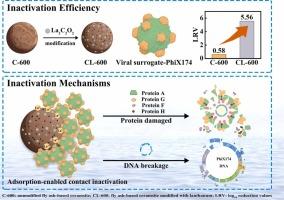镧改性粉煤灰陶粒可持续水传播病毒灭活:性能和机制
IF 11.3
1区 环境科学与生态学
Q1 ENGINEERING, ENVIRONMENTAL
引用次数: 0
摘要
水传播病毒对公众健康构成重大威胁,特别是在再生水系统中。传统的消毒技术通常表现出有限的病毒去除效率,特别是在不同的水质条件下,并且可能导致消毒副产物的形成。本研究合成了一种用镧(CL-600)修饰的粉煤灰基陶粒,并对其对噬菌体PhiX174的抗病毒效果进行了评价。CL-600对PhiX174的最大去除率为5.56-log10,显著高于未改性陶粒的0.58-log10。这种去除是剂量依赖性的,同时克服了传统材料常见的团聚问题。此外,CL-600在pH 5-9范围内保持高度失活,即使在高病毒载量或天然有机物质下也是如此。CL-600的主要失活机制是在表面La位点的吸附使接触失活。结构分析显示衣壳蛋白受损,包括蛋白A、F、H和g。此外,DNA暴露导致9对功能基因受损,其中最显著的损伤与基因H对应,这些结构损伤破坏了病毒的附着、注射和复制功能,导致传染性降低。该研究表明,CL-600在水媒病毒灭活方面具有较高的效率,突出了镧基材料在可持续水安全管理方面的潜力。本文章由计算机程序翻译,如有差异,请以英文原文为准。

Lanthanum-modified fly ash ceramsite for sustainable waterborne virus inactivation: Performance and mechanism
Waterborne viruses pose a significant threat to public health, particularly in reclaimed water systems. Conventional disinfection technologies often exhibit limited viral removal efficiency, especially under varying water quality conditions, and may contribute to the formation of disinfection by-products. In this study, a fly ash-based ceramsite modified with lanthanum (CL-600) was synthesized and evaluated for its antiviral efficacy against bacteriophage PhiX174. CL-600 demonstrated a maximum removal efficiency of 5.56-log10 for PhiX174, significantly surpassing the 0.58-log10 of unmodified ceramsite. This removal was dosage-dependent while overcoming the agglomeration issues common to traditional materials. Moreover, CL-600 maintained high inactivation across pH 5-9, even under high viral loads or natural organic matter. The primary inactivation mechanism of CL-600 was identified as adsorption-enabled contact inactivation at surface La sites. Structural analysis revealed damage to the capsid proteins, including proteins A, F, H and G. Furthermore, DNA exposure led to damage to nine pairs of functional genes, with the most significant damage corresponded to gene H. Collectively, these structural damages disrupted viral attachment, injection, and replication functionalities and leading to reduced infectivity. This study demonstrated that CL-600 provides a high efficiency in waterborne virus inactivation, highlighting the potential of lanthanum-based materials for sustainable water safety management.
求助全文
通过发布文献求助,成功后即可免费获取论文全文。
去求助
来源期刊

Journal of Hazardous Materials
工程技术-工程:环境
CiteScore
25.40
自引率
5.90%
发文量
3059
审稿时长
58 days
期刊介绍:
The Journal of Hazardous Materials serves as a global platform for promoting cutting-edge research in the field of Environmental Science and Engineering. Our publication features a wide range of articles, including full-length research papers, review articles, and perspectives, with the aim of enhancing our understanding of the dangers and risks associated with various materials concerning public health and the environment. It is important to note that the term "environmental contaminants" refers specifically to substances that pose hazardous effects through contamination, while excluding those that do not have such impacts on the environment or human health. Moreover, we emphasize the distinction between wastes and hazardous materials in order to provide further clarity on the scope of the journal. We have a keen interest in exploring specific compounds and microbial agents that have adverse effects on the environment.
 求助内容:
求助内容: 应助结果提醒方式:
应助结果提醒方式:


